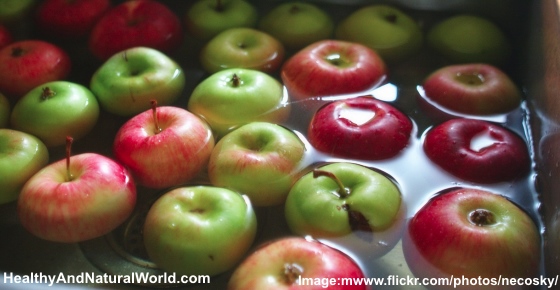How to Easily Remove Pesticides From Your Fruits and Vegetables

Did you know that 65% of produce samples analyzed by the U.S. Department of Agriculture test positive for pesticide residues? Unless you’re buying certified organic food, the chances are that you’re consuming a significant amount of chemicals with every portion of your ‘healthy’ greens.
The Environmental Working Group (EWG) is trying to inform the public about the level of exposure to often toxic chemicals commonly found in our fresh produce. They publish an annual list of most and least contaminated fruits and vegetables, the so called ‘Dirty Dozen’ and ‘Clean Fifteen’ lists.
Apples, strawberries, grapes, celery, peaches, spinach, sweet bell peppers, imported nectarines, cucumbers, cherry tomatoes, imported snap peas and potatoes are all on the EWG’s Dirty list.
You should be careful when consuming these produce, as they contain a number of different pesticide residues and have high concentrations of pesticides relative to other produce items.
The cleanest fruits and veggies, which are least likely to hold pesticides, include avocados, sweet corn, pineapples, cabbage, frozen sweet peas, onions, asparagus, mangoes, papayas, kiwis, eggplant, grapefruit, cantaloupe, cauliflower and sweet potatoes. Avocados are the cleanest, with only 1% showing any detectable pesticides (you can find here more healthy reasons to eat avocado).
How to Make Fruits and Vegetables Safer for Consumption?
Use Vinegar and Water to wash pesticides and chemicals
There is a simple and cheap trick that can help you get rid of those nasty chemicals. You can simply wash your fresh produce in distilled white vinegar and water solution.
Gayle Povis Alleman, a registered dietician, suggests soaking your veggies and fruits in a solution of 10% vinegar to 90% water. Make the mixture, and let the produce sit in for 15 to 20 minutes. When you remove them, you’ll notice that the water left in the bowl is dirty and may contain some gunk. Rinse fruits and vegetables in fresh water, and then enjoy your cleaner product.
This method shouldn’t be used on fragile fruits, such as berries, as they have a very porous skin and might get damaged and soak in too much of the vinegar. With other fruits, there should be no lingering vinegar aroma. If you wish, you can also use lemon juice.
Water and salt is also helpful
According to the Center for Science and Environment (CSE), it also helps to wash your fruits and vegetables with 2% of salt water. This should remove most of the contact pesticide residues that normally appear on the surface.
In a scientific study, researchers washed cabbage for 20 minutes in vinegar, a salt water solution, or tap water to eliminate concentration of pesticide residues. The researchers found that vinegar and salt water solutions were significantly better than tap water in removing pesticides from the cabbage.
They discovered that a 10% salt water solution was the most effective, and far better than washing with plain water.
Baking soda and water could be the most effective washing method
A new study from The University of Massachusetts, Amherst, suggests another method that may also be effective in removing pesticides from produce: soaking them in a solution of baking soda and water.
The study checked the effectiveness of commercial and homemade washing agents in removing pesticide residues from apples. It was found that the baking soda method was more effective in removing surface pesticide residues on apples than tap water and bleach.
The researchers mentioned that the standard post-harvest washing method (using Clorox bleach solution for 2 minutes) is less effective than baking soda and water.
However, the researchers found that the baking soda method was not completely effective in removing pesticides that have penetrated into the apple peel. They found that the effectiveness of this method diminished when pesticides penetrated deeper into the fruit. The researchers concluded that washing apples with baking soda solution can reduce pesticides mostly from the surface of the apples.
Washing Produce – A Few tips
Generally speaking, you should be thorough when washing fruits and vegetables, as chemicals can linger in crevices that are hard to wash.
The Center for Science and Environment claims that if done diligently, washing with cold water should be able to remove 70% to 80% of all pesticides.
It is important to invest some time in preparing your food, as you don’t want to end up consuming a portion of toxins with your snack. The American Academy of Pediatrics issued an important scientific report in 2012 that said that children have unique susceptibilities to pesticide residues’ potential toxicity. By washing your food carefully, you protect the health of your whole family.
Washing your produce to remove pesticides is also one of the 70 habits featured in my e-book 70 Powerful Habits For A Great Health which will guide you how to take positive steps to improve your wellness and overall health.
Related articles:
